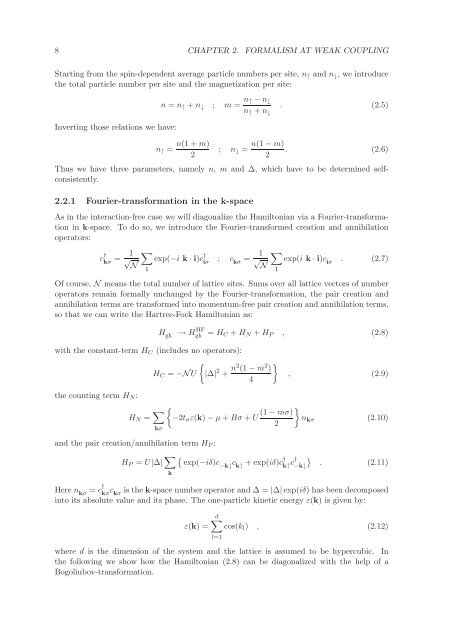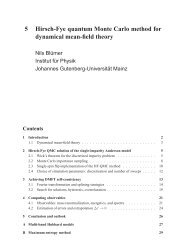Hubbard Model for Asymmetric Ultracold Fermionic ... - KOMET 337
Hubbard Model for Asymmetric Ultracold Fermionic ... - KOMET 337
Hubbard Model for Asymmetric Ultracold Fermionic ... - KOMET 337
You also want an ePaper? Increase the reach of your titles
YUMPU automatically turns print PDFs into web optimized ePapers that Google loves.
8 CHAPTER 2. FORMALISM AT WEAK COUPLINGStarting from the spin-dependent average particle numbers per site, n ↑ and n ↓ , we introducethe total particle number per site and the magnetization per site:Inverting those relations we have:n = n ↑ + n ↓ ; m = n ↑ − n ↓n ↑ + n ↓. (2.5)n ↑ =n(1 + m)2; n ↓ =n(1 − m). (2.6)2Thus we have three parameters, namely n, m and ∆, which have to be determined selfconsistently.2.2.1 Fourier-trans<strong>for</strong>mation in the k-spaceAs in the interaction-free case we will diagonalize the Hamiltonian via a Fourier-trans<strong>for</strong>mationin k-space. To do so, we introduce the Fourier-trans<strong>for</strong>med creation and annihilationoperators:c † kσ = √ 1 ∑exp(−i k · i)c † iσ; c kσ= 1 ∑√ exp(i k · i)c iσ. (2.7)N NiOf course, N means the total number of lattice sites. Sums over all lattice vectors of numberoperators remain <strong>for</strong>mally unchanged by the Fourier-trans<strong>for</strong>mation, the pair creation andannihilation terms are trans<strong>for</strong>med into momentum-free pair creation and annihilation terms,so that we can write the Hartree-Fock Hamiltonian as:H gk → H HFgk = H C + H N + H P , (2.8)iwith the constant-term H C (includes no operators):{H C = −NU |∆| 2 + n2 (1 − m 2 })4, (2.9)the counting term H N :H N = ∑ kσ{−2t σ ε(k) − µ + Bσ + U}(1 − mσ)n kσ (2.10)2and the pair creation/annihilation term H P :H P = U|∆| ∑ k{exp(−iδ)c−k↓ c k↑+ exp(iδ)c † }k↑ c† −k↓ . (2.11)Here n kσ= c † kσ c kσis the k-space number operator and ∆ = |∆|exp(iδ) has been decomposedinto its absolute value and its phase. The one-particle kinetic energy ε(k) is given by:ε(k) =d∑cos(k l ) , (2.12)l=1where d is the dimension of the system and the lattice is assumed to be hypercubic. Inthe following we show how the Hamiltonian (2.8) can be diagonalized with the help of aBogoliubov-trans<strong>for</strong>mation.













